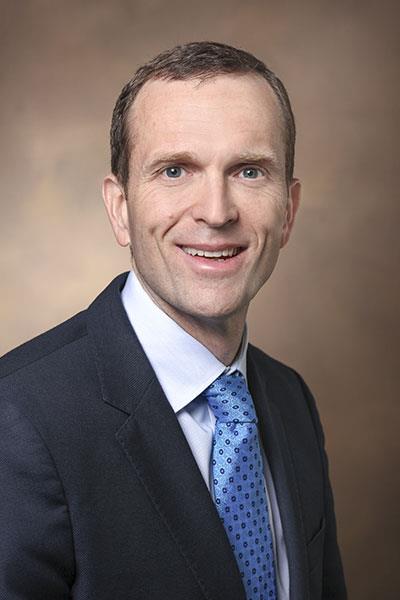Injections of botulism toxin A (BTX-A) have been used for three decades in the treatment of spasmodic dysphonia and vocal tremor by stifling the muscles involved in the disorders, which originate from abnormal brain signaling.
During that time, varying degrees and types of vocal disfunction have been seen at the Vanderbilt Voice Center, providing depth of experience and research opportunities that support personalized treatment protocols, said VUMC otolaryngologist K. Charles Fletcher, M.D.
For example, a 2022 study by the Vanderbilt Voice Center examined the medical value of using BTX-A –- marketed commercially as Botox or Dysport – on one vocal cord versus both at the same time, as has been the traditional procedure.
“We have this experience over time on bilateral and unilateral injections, mixed dosing, and making dose adjustments to manage side effects. We wanted to share what we have found effective,” said Fletcher, an author on the study led by C. Gaelyn Garrett, M.D., MMHC, senior executive medical director of the Vanderbilt Voice Center and president of the American Board of Otolaryngology – Head and Neck Surgery.
Their team also includes a laryngologist and multiple speech and language pathologists who treat up to 30 patients a day two to three times a week with Botox injections.
Patient Categories
About 80 percent of patients with SD have laryngeal closing muscles that spasm, Fletcher said. In these cases, BTX-A, a acetylcholine-blocker, relaxes the spasm by impeding neurotransmission within the muscle.
“In most of these patients, the bilateral muscles overtighten when they try to voice a long ‘e’, leaving them with broken, staccato speech,” Fletcher explained. “Paralyzing one or both of the adductor muscles can relieve this.”
In the other 20 percent of SD patients, spasms of the opening muscles of the vocal cords create vocal breaks when the person makes sounds that keep the vocal cords open such as “ha” and “pa,” he explained. Botox can reduce these spasms and decrease the periodic breaks in the patient’s voice.
By paralyzing adductor muscles, it can also help many patients with vocal tremor, a rhythmic spasm of the muscle that makes speech effortful and shaky, Fletcher says.
Administering Botox
For adductor SD and vocal tremor, the physician uses electromyography to target the adductor muscles in the vocal cords and then places the needle into the vocal cord just beneath the larynx and below the Adam’s apple. Targets can be as small as a 15 x 5 mm rectangle.
The abductor muscles reside behind the adductors, and since treatment carries a small risk of affecting breathing and swallowing, a transnasal flexible or transoral endoscope may be used to guide treatment.
For the majority of their patients with adductor SD, the right injection gives the patient a couple of days of a somewhat breathy voice, followed by 10 or 11 weeks of “good” vocalization. Then, at week 12, it is “rinse and repeat,” Fletcher said.
Finding this sweet spot between underdosing and having no effect, and overdosing and potentially affecting breathing and swallowing, is the art of the treatment.
The Vanderbilt Voice Clinic’s team of speech pathologists evaluates patients’ voices along a wide treatment continuum and have eased off from a tendency to begin with larger dosing to balance the patient’s response to treatment, both positive and negative.
“Overall, we’ve evolved from giving fairly big doses on both sides to smaller doses, and often only on one side,” Fletcher said.
Unilateral, Bilateral
By analyzing data from their patients, the researchers have found that just 1.25 units injected in just one vocal cord was effective for many patients with adductor SD or voice tremor.
“We might do this instead of bilateral injections at smaller doses. Reduction of side effects with preserved benefit is high with unilateral doses, so that has been our direction to start in many cases,” Fletcher said.
Abductor muscles are larger, so doses are higher, but Fletcher says unilateral injections are more often used there to avoid the risk of breathing or swallowing problems.
“The beauty of Botox is that we’re not creating irreversible surgical changes. You have the ability to adjust the dose every 12 weeks.”
In all populations, treatment is often alternated from side to side, though one side may work better and become the ongoing target.
“Dosing and strategies for an individual may also change over time,” he said. “It’s like landing a plane on an aircraft carrier. Sometimes it speeds up, and you have to adjust your pattern to make the landing,” Fletcher said. “But the beauty of Botox is that we’re not creating irreversible surgical changes. You have the ability to adjust the dose every 12 weeks.”
Treatment at the Source
While laryngeal application of BTX-A is the current standard treatment for spasmodic dysphonia and vocal tremor, there is reason to hope for treatment options that address their origins in the central nervous system may become available.
For example, the researchers say there is anecdotal evidence that high-frequency ultrasound ablation for generalized benign essential tremor may have a role in relieving vocal tremor. Fletcher’s team is already in discussion with functional neurosurgeons at Vanderbilt about future collaborations to explore this option.
“This is the ultimate goal, and I would be very happy to give up my entire Botox practice if there was a reliable way to treat these disorders at their source,” Fletcher said.





